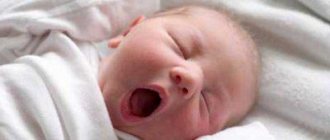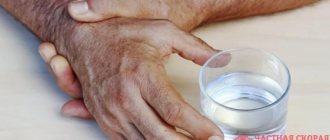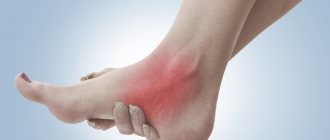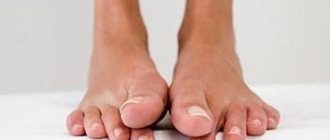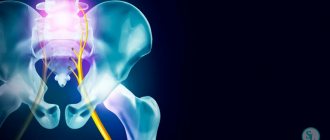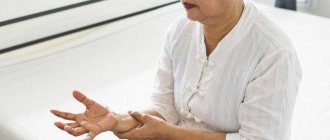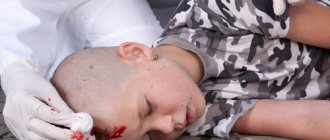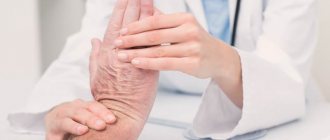Tremor in infants is most often twitching of the arms and chin . Similar to muscle hypertonicity, tremor is considered a sign of a lack of sufficient maturity of the baby’s nervous system and its significant excitability.
Most often, muscle contractions in newborns are recorded periodically during severe fright, screaming, crying, REM sleep (with noticeable eye movements) or feelings of hunger.
If the intensity of tremor in newborns is high and the amplitude is small, then these are the characteristics of the nervous system of the newborn.
Tremor is a fairly common phenomenon, occurring in approximately half of newborns, and is considered normal in the first months of life (by 3-4 months all signs of tremor should disappear).
Chin tremor in a newborn under 1 year of age is also rarely a cause for concern and does not require treatment, since it is often a benign, age-related, specific condition of the nervous system.
However, if parents notice a tremor in a child, it is better to consult a pediatrician.
The baby’s nervous system is very flexible and very susceptible to external influences, so proper treatment can easily normalize and restore it.
Causes of tremors in infants
The most common causes of tremor can be:
- immaturity of the nervous system;
- fetal hypoxia;
- premature birth.
Immaturity of the nervous system
In the first weeks of a baby’s life, he lacks coordination of movements, and the nervous system is immature. These factors cause limb tremors in newborns.
Muscle hypertonicity also increases the likelihood of tremors. Also, during the manifestation of emotions, an increased level of norepinephrine may be observed in the baby’s blood.
Fetal hypoxia
During pregnancy and during childbirth, there is a risk of disturbances in placental blood flow, which can negatively affect processes in the brain. Hypoxia can be a consequence of:
- intrauterine infection;
- dysfunction of the placenta;
- bleeding;
- increased uterine tone (threat of miscarriage);
- polyhydramnios.
Problems with the child’s nervous system can be caused by both rapid labor and weak labor , as well as placental abruption and entanglement of the fetus with the umbilical cord.
The above factors impede the access of oxygen to the brain, which leads to tremor of the arms, legs and chin in newborns.
Premature birth
A premature baby is most often susceptible to tremors of the lips, legs or chin.
This happens because their nervous system, in principle, is not mature. She has to complete her formation outside the mother’s womb, where there are no and cannot be any conditions close to her, even in the case of adequate and careful care.
What is tremor and what happens in newborns?
During feeding or strong crying of the child, parents may notice that his chin is trembling or his arm, leg, or head are twitching. This is how tremor manifests itself in infants (small spasms affecting the muscles). Its appearance is facilitated by the reaction of nerve fibers (compensatory), which are immature.
Tremor can occur in two types:
- Physiological
- Pathological.
What does physiological tremor look like:
- Insignificant twitching amplitude;
- There is rhythm;
- Most often occurs when the child is crying;
- Manifests as twitching of the lower lip or chin, but may involve the upper and lower extremities;
- It is characterized by both symmetry and asymmetry. Therefore, you can see how the child’s leg or two are twitching at the same time.
The baby’s condition with physiological tremor often stabilizes within a few seconds after its appearance. And it occurs at the moment when the baby cries, is in REM sleep or feels hungry. Sometimes you can notice symptoms after bathing the baby or against the background of the appearance of colic.
Tremor may appear in the first days of a newborn's life. If it is physiological, then over time its episodes become less frequent and disappear altogether. Most often, this problem is faced by parents of children whose birth was premature.
In the case of pathological tremor, you may encounter the following:
- In addition to twitching the lips, chin, legs or arms, the head is also involved;
- The intensity of the episodes gradually increases, they can occur for no reason;
- Muscle cramps can spread to the baby’s entire body;
- The condition and behavior of the baby changes - he is increasingly capricious, and sleep disturbances can be observed.
The manifestation of these symptoms is a reason to contact a neurologist. Thanks to this, the development of many neurological diseases can be prevented.
You can encounter tremors in babies for several reasons:
- The nerve centers in the brain are not mature enough;
- The blood serum contains a high concentration of norepinephrine. This is a hormone that is responsible for the transmission of nerve impulses.
This problem occurs in almost every child born prematurely. But full-term babies can also encounter it. If the tremor is physiological in nature, then this phenomenon is considered normal.
The main reason for twitching of the limbs, chin and other parts of the body in a newborn is a fragile and incompletely formed nervous system. This can happen due to the fact that there is a large amount of norepinephrine in the maternal blood. Oxygen starvation can also contribute to this.
Why this might happen:
- While carrying the baby, the expectant mother learned about a diagnosis such as fetal hypoxia;
- During pregnancy, the woman was exposed to stress;
- There was a threat of abortion for medical reasons;
- The expectant mother was a carrier of infectious diseases;
- The course of labor was rapid;
- The baby was wrapped in an umbilical cord;
- The placenta has separated;
- During the period of bearing the baby, injuries occurred.
In what cases is targeted treatment necessary?
If signs of tremor are observed for longer than 3 months, spread to the legs and head, and are not associated with the characteristics of the nervous system or a feeling of hunger, then this should cause alarm among parents.
This may result in:
- intracranial hemorrhage;
- hyperglycemia;
- hypocalcemia;
- hypoxic-ischemic encephalopathy;
- hypomagnesemia;
- drug withdrawal syndrome;
- sepsis and increased intracranial pressure.
Targeted treatment of tremor in newborns is mandatory after a traumatic brain injury or infectious disease.
In such cases, systematic observation should be carried out by a pediatric neurologist.
How to help a child
If the cause is a disease, then you should consult a doctor. If the symptom is a result of stress, then relaxing activities are sufficient.
Massage
You can perform a relaxing massage twice a day. Before doing this, you need to consult a specialist. It is not difficult to master the technique; massages are prohibited without prior training.
Massage for a baby with tremors
Exercises
You can also do special exercises aimed at relaxing muscles.
Calm environment
Creating a favorable emotional climate has a positive effect on the development of the child. Therefore, parents should not quarrel and resolve conflict situations calmly, taking into account each other’s interests.
Important to remember ! The baby becomes infected with the emotional state of the parents.
Walk
This is one of the most important things a parent can do for their baby's health. A walk helps you get rid of stress and begin to explore the world.
Treatment methods
The treatment method for tremor of the arms, legs, and head in a child is aimed at restoring the health of the baby in general and the nervous system in particular.
The recommendations of a pediatric neurologist should be strictly followed.
Massage for tremors in infants
In addition, parents definitely need to create a pleasant, cozy and friendly environment around their baby, systematically massage their baby (it promotes relaxation), instill swimming skills (this is possible even in a home bath), and do therapeutic exercises with him.
Such efforts of parents will not be in vain.
The easiest way to master massage techniques for newborns (from the age of 5-6 weeks) at home. The pediatrician will definitely teach mom and dad basic massage movements, based on which you can then proceed to perform a variety of exercises.
The basic massage movements are:
- vibration;
- kneading;
- trituration;
- stroking.
The basic rule is that all massage movements are performed from the periphery to the center (along the joints).
An important role is played by the baby’s psychological mood and his physical comfort during the massage:
- The room needs to be ventilated, this will take 20-30 minutes (if the weather is warm outside, then the massage can be performed with the window open);
- Hands must be dry, bracelets and rings must be removed, nails must be trimmed;
- Before starting the massage, you should shake your hands and rub your palms together so that they become warm;
- The massage session is carried out during the baby’s active waking hours; it is always necessary to ensure that he is in a good mood. If the mood deteriorates, you need to stop for a while, cheer up the child and you can continue;
- The place where the massage is performed should be familiar to the baby; it is convenient to do it on the changing table;
- Nothing should disturb the child, for example, the sun shining in his eyes;
- When doing a massage, it is useful to talk with the baby, smile, sing songs, it is better if the facial expressions are emotionally rich;
- Massage is always accompanied by stroking;
- There is no need to use aromatic oils or powder so as not to clog delicate pores (it is better to use regular products used for daily moisturizing for massage purposes);
- The highest effect of massage is observed before water procedures;
- Movements should be smooth. The massage begins with the face: in this case, it is necessary to stroke the baby along the edges and along the wings of the nose.
How tick-borne borreliosis manifests itself - symptoms and signs that will leave no doubt.
Is it possible for newborns to use the medicine Diacarb? We have collected reviews from doctors and patients, contraindications and indications for the medication in one review.
Basic exercises
Here are some basic exercises:
- "Hammer" . When the child is lying on his back, you need to clasp the right foot with one hand and tap the outside of the leg from bottom to top with the fist of the other. Next, the exercise is repeated with the foot of the other leg.
- “Stroking our hands . The baby's arm is fixed with the left hand, and the right hand gently clasps the shoulder. When lowering to the wrist, you should make shaking movements. Do the exercise 2-3 times and move on to the other hand. Using similar tactics, you can perform the “Stroking the Legs” exercise.
- "Watch" . Exercise also helps children with intestinal problems. The baby's tummy should be stroked clockwise for 5-7 minutes.
- "Toptyzhka" . The baby lies on his tummy, and the masseur gently kneads his buttocks with his fists. To keep your baby occupied, it is recommended to place a bright, interesting toy in front of him. He will look at her, reach for her, and thus the back and neck muscles will be activated.
- "Herringbone" . In the direction from the back to the coccyx and at an angle to the spine, it is necessary to make stroking movements.
Treatment of restless legs syndrome in children
The list of diagnostic options in this situation is limited, so most studies are aimed at excluding other possible causes of seizures and insomnia. Shown:
- biochemical blood test with mandatory determination of the level of ferritin, transferrin, serum iron, glycated hemoglobin, glucose, vitamins;
- EEG, ultrasound and Dopplerography of cerebral vessels;
- a general blood test, the results of which pay attention to the erythrocyte sedimentation rate, leukemia formula and other possible signs of the inflammatory process;
- immunogram (if an autoimmune disease is suspected);
- electroneuromyography.
The specialists of our medical center begin treatment of RLS with non-drug methods. Recommended:
- Massage. You can do it yourself, but it is better to seek help from a specialized specialist.
- Water procedures: a warm bath shortly before bedtime, preferably with the addition of herbal decoctions that have a sedative effect.
- Normalization of the daily routine, nutrition correction. If the child already eats “adult” food, the diet must contain foods rich in iron and B vitamins (boiled meat, fish, eggs, many cereals, etc.).
- Minimizing the influence of stress factors. Perhaps it is necessary to reduce the child’s stay in the kindergarten, organize family leisure, joint recreation, but under no circumstances should overwork be allowed.
- Regular walks in the fresh air.
Drug treatment is “connected” if there is no effect from the above measures. They use sedatives and, according to strict indications, anticonvulsants, which are used in pediatrics for the treatment of childhood epilepsy.
You can get more detailed information, sign up for a consultation or call a specialist at home from our operators by phone .
conclusions
Pediatrics operates with the concept of a critical time for a child’s development after birth, especially with regard to the nervous system, disturbances in the functioning of which can cause tremors in newborns.
The 1st, 3rd, 9th and 12th months of a baby’s life are considered critical periods, when nerve endings are highly sensitive and any deviation from the norm can lead to the development of certain pathologies.
To prevent the development of serious problems that may be the cause of tremors, systematic monitoring of the child’s health is strongly recommended. If you notice signs of tremor in a newborn, there is no need to panic, but you should definitely contact a neurologist.
Types of tremor
Different diseases have their own characteristic signs, and in order to figure out why your hands are shaking, the doctor clarifies how exactly the pathology manifests itself. Thus, a distinction is made between resting tremor and action tremor.
In the first case, involuntary movements occur when a person does not do any active actions (just sits, stands, lies). In the second case, the opposite is true: during rest there is no trembling, but as soon as a person wants to do something (pick it up, put it down, etc.), uncontrolled muscle contractions begin.
In addition, doctors distinguish between several types of tremor depending on the source of the disorder. For example, if tremors are associated with damage to the cerebellum, they speak of cerebellar tremor; if nerve fibers are damaged, neuropathic tremor is diagnosed. One of the most difficult cases is damage to the midbrain (rubal tremor). If your medical record says “dystonic tremor,” then the problem is related to disturbances in the functioning of the muscular system.
Figure 6 - Cerebellum
If the tremor is caused by pathology
The following signs should alert a parent:
- Synchronous tremor of the head, chin, arms and legs. Separately they can shake, but together it is undesirable.
- Duration more than 30 seconds. If the duration is short, we are talking about minor age-related disorders of the functioning of the nervous system. If the duration is more than 30 seconds, there may be increased seizure activity or other health problems.
- Blueness of the skin.
- The child continues to sleep and tremble, although he has already reached the age of six months.
- Difficult childbirth.
